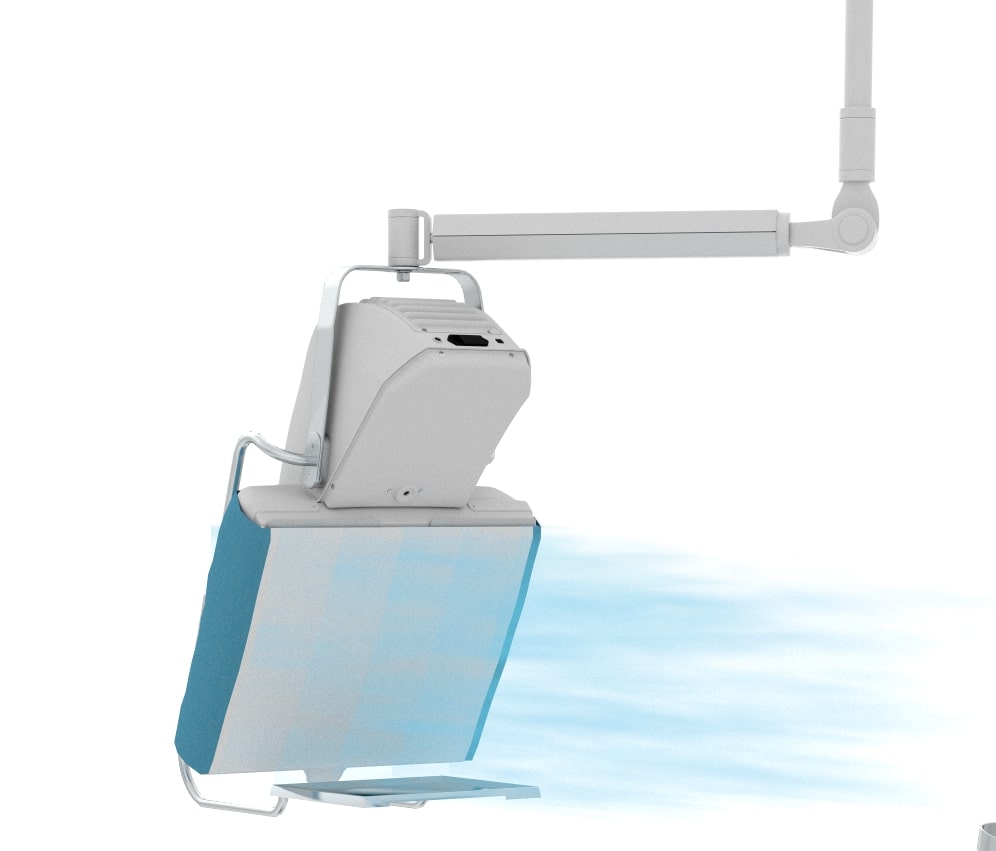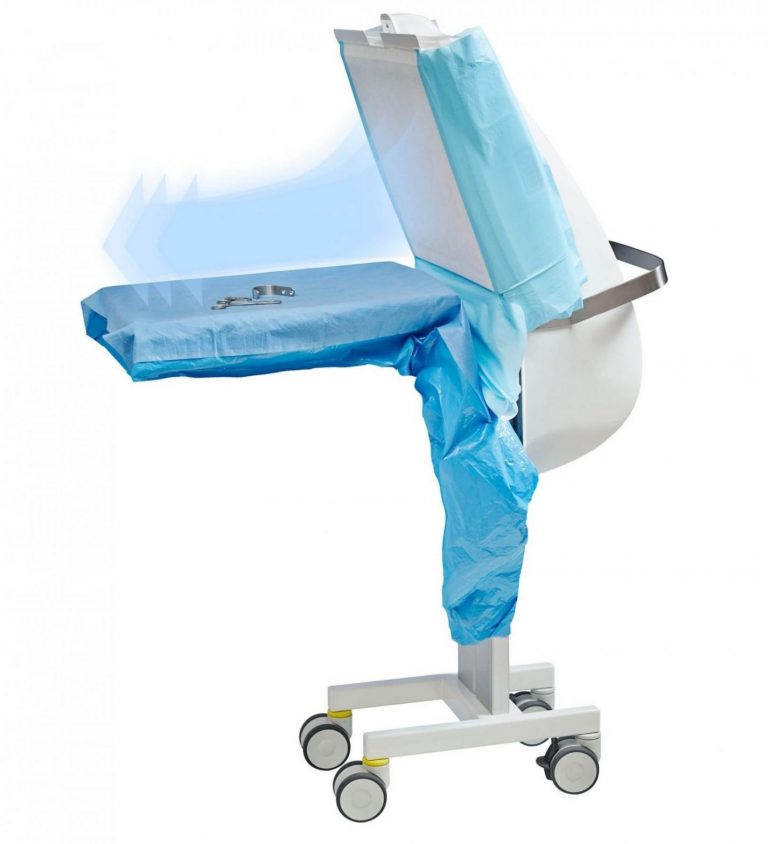
Steristay: The World’s First Instrument Table with Integrated HEPA Filter
Steristay is a groundbreaking solution in surgical hygiene, offering the first instrument table that ensures instruments and implants remain sterile throughout surgery. This innovation addresses a critical gap in operating room protocols, where surgical instruments are often left unprotected and vulnerable to contamination for extended periods.
The Problem: Contaminated Instruments Cause Infections
While implants are opened only at the last moment to ensure sterility, the instruments used for implantation remain exposed on traditional instrument tables. This exposure significantly increases the risk of contamination and surgical site infections. read more
Key Facts:
- Source of Contamination: The primary source of bacteria in the operating room is not the air but the people present, who shed hundreds to thousands of bacteria-bearing particles per minute (Bethune, 1975; Whyte et al., 1976, 1978). read more
- Impact on Joint Prostheses: Studies estimate that 90% of early perioperative infections in joint prostheses result from microbial contamination during surgery (Uckay et al., 2009).
- Prolonged Operations: Instruments prepared outside sterile zones (ISO 5) in conventional operating rooms (ISO 7) are quickly contaminated, increasing infection risks as surgery duration extends read more
Steristay: A Revolutionary Solution
Steristay ensures that instruments and implants remain sterile during both preparation and surgery, addressing a critical need for enhanced surgical hygiene.
How It Works: read more
- Integrated HEPA Filtration: Steristay uses a HEPA H14 filter to create a sterile zone on the instrument table, eliminating 99.995% of bacteria, microorganisms, and viruses, including COVID-19.
- Protection Throughout the Procedure: Steristay maintains sterility even during long and complex surgeries, safeguarding instruments and implants from contamination.
- ISO 5 Sterile Zones: Steristay provides an ISO 5 sterile zone directly at the point of use, mitigating the limitations of small laminar airflow ceilings that fail to cover the instrument preparation area.
- Cost-Effective: Avoids costly postoperative infections, with studies showing that infections can cost €40,000–50,000 per case.
- Backed by Research: Proven effective in maintaining sterility through peer-reviewed studies.
Prevention of Periprosthetic Infections: Addressing Hidden Risks
Periprosthetic infections remain one of the most severe complications following knee and hip arthroplasty, with the majority only becoming evident after hospital discharge. According to data from Switzerland (Staszewicz et al. 2014, Troillet et al. 2017), 80% of wound infections for hip prostheses and 95% for knee prostheses are detected post-discharge. This suggests that if infection rates are only recorded in-house, the actual infection rates may be at least 80% higher than reported. read more
Understanding the True Source of Infections
Contrary to common assumptions, bacteria do not primarily enter the wound via the air; the likely culprits are contaminated instruments.
Key Questions:
- Would you open a prosthesis at the start of an operation?
Any surgeon would firmly say “no,” emphasizing the need to open artificial hip or knee prostheses at the last possible moment to prevent contamination. - How long have the instruments used to insert the prosthesis been exposed?
Instruments left unprotected during surgery are a critical source of contamination, increasing the risk of infection.
The Reality of Operating Rooms
While many believe that operating rooms (ORs) are ultra-clean, even sterile environments, professionals know this is far from the truth.
Factors Increasing OR Contamination:
- Human Presence:
Every person entering the OR introduces pathogens into the environment, significantly increasing contamination levels. The more people present, the higher the risk. - Continuous Particle Shedding:
Despite wearing surgical clothing, each person releases 200 to 500 bacteria per minute into the OR environment (Hyg + Med, 1987). These particles can settle on surfaces, including instruments, and contribute to infections.
The Need for an Aseptic Environment
Certain procedures, such as implant surgery and eye surgery, require an extremely aseptic environment, as even minimal contamination can lead to devastating and costly infections.
Key Takeaways for Infection Prevention
- Sterile Instrument Protocols: Instruments used in surgery must be continuously protected to prevent contamination.
- Enhanced OR Hygiene: Measures to reduce particle shedding and contamination in the OR are essential, especially for high-risk surgeries.
- Comprehensive Monitoring: Infection rates should include post-discharge data to provide an accurate understanding of risks and outcomes.
Investing in Preventative Solutions
Modern surgical practices must address the hidden risks posed by instrument contamination and OR environment management. Adopting innovative tools and strict protocols can significantly reduce infection rates, protect patients, and lower the financial burden on healthcare systems. read more
Contact Normeditec for Advanced Surgical Solutions
We’re dedicated to helping you enhance your surgical environment with the Operio Mobile Laminar Air Flow Unit. Reach out to us for expert advice, detailed product information, or personalized assistance tailored to your needs.
Contact Information
- Email: info@normeditec.com
- Phone:
- Germany: +49 7139 2090859
- Italy: +39 348 730 24 45
- WhatsApp Support:
- Germany: +49 176 62 13 16 34
- Italy: +39 348 730 24 45
- Languages Spoken: English, German, French, Italian
- Website: www.normeditec.com
Global Reach and Expert Support
We deliver worldwide and are available via video call for real-time support and guidance. Let us help you implement cutting-edge aseptic solutions to revolutionize your practice.
Contact us today to take your surgical solutions to the next level!
Technical information
Benefits
Ready-to-Use Solution: No Structural Modifications Required
The Operio Laminar Air Flow system operates seamlessly with existing supply-air ceilings, ensuring a turbulence-free sterile environment
The Operio Laminar Air Flow system provides unparalleled protection against instrument and implant contamination, especially during lengthy procedures such as implants and transplants.
Extend Protective Zones of Existing Ventilation Systems Without Construction Works
"Comfortable and Quiet Operation: No Cold Air or Drafts
Applications
Related products
Related products

Ceiling unit
The Operio Ceiling Laminar Air Flow Unit is the ultimate solution for achieving top asepsis in operating rooms, all while taking up the smallest possible space. Designed to meet the needs of modern surgical environments, this ceiling-mounted unit delivers unmatched efficiency and sterility, ensuring patient safety and optimized surgical outcomes.
View product
Operio portable laminar air flow
The Operio Mobile Laminar Air Flow Unit provides ISO 5 sterile conditions, transforming conventional operating rooms and outpatient surgical spaces into ultra-clean environments. Its focused sterile airflow protects the surgical field and instruments, ensuring maximum sterility for eye surgeries, ENT procedures, day surgeries, cardiology, all types of implant surgeries, plastic and aesthetic surgeries, orthopedic operations, and more. Ideal for enhancing infection control and surgical precision across diverse medical disciplines.
View product
 it
it en
en fr
fr de
de










